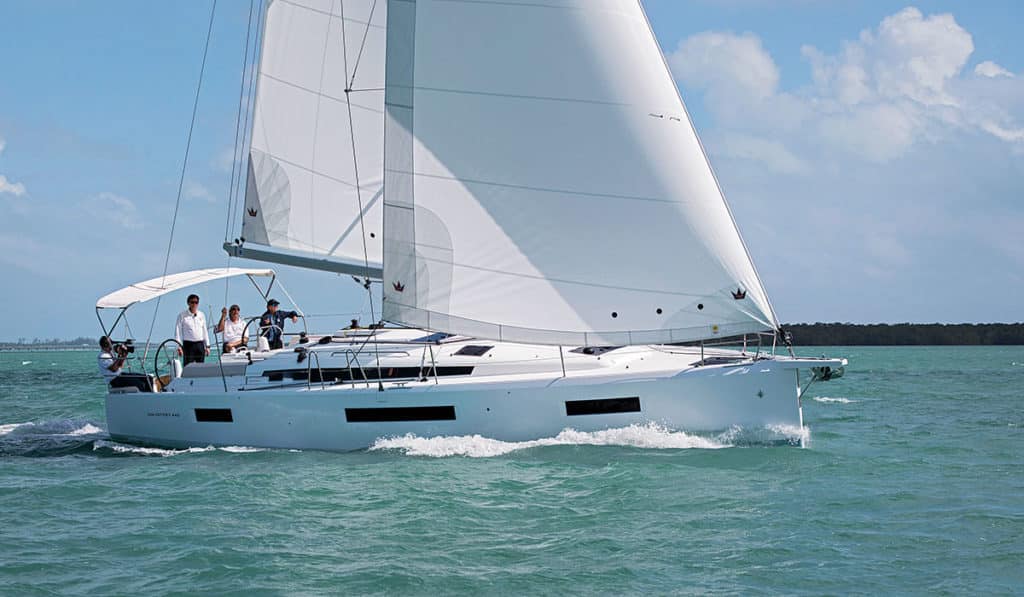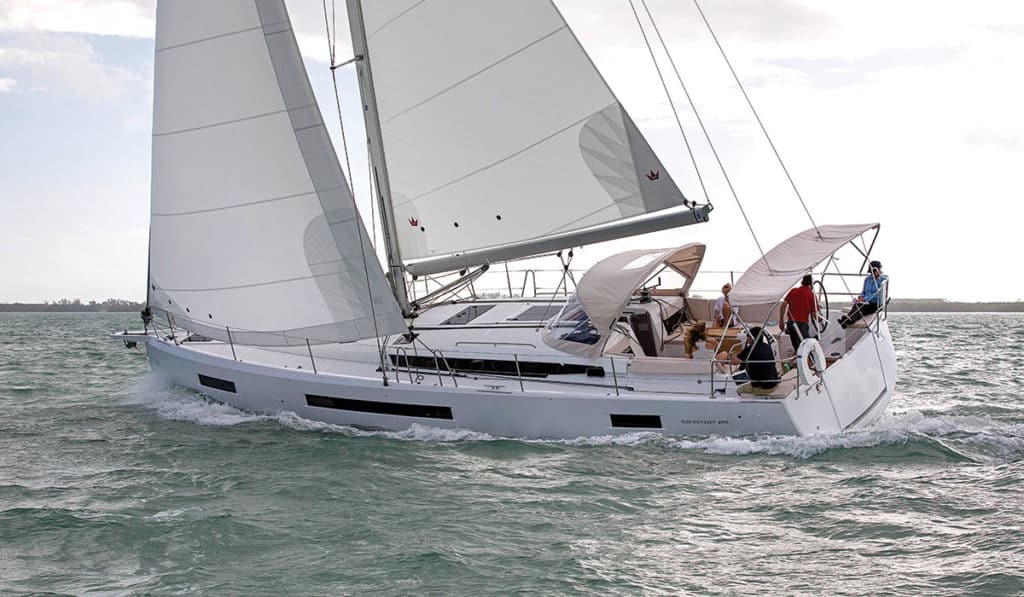
Every 10 years or so, a new wrinkle in boat design or layout comes along that alters the way in which we perceive cruising boats. Way back when (OK, more than a decade ago), it was the not-so-subtle shift from full-keel yachts to those with fin blades and skeg-hung rudders. More recently, raised deck saloons changed the way we looked at interior spaces, opening up the main living area with wraparound windows, more light and headroom, and panoramic views. Then came chines, once the purview of metal boats but suddenly ubiquitous in fiberglass production craft, with claims of better performance (maybe) and voluminous accommodations (definitely). And let’s not forget the explosion of cruising catamarans, which are a separate discussion altogether.
Now, with the introduction of Jeanneau’s Sun Odyssey 440 and 490 — the first models launched in the eighth generation of the company’s Sun Odyssey line (time flies!) — we may be witnessing yet another shift in the evolution of mass-produced cruisers. It’s too early to tell, of course, but this latest design wrinkle totally impressed our judging panel in last fall’s Boat of the Year contest, so much so that they unanimously dubbed the 440 the Most Innovative yacht for 2018 (see “A Most Unusual Year,” January 2018).
So what, exactly, is this revolutionary innovation? The deck layout and, especially, the cockpit configuration. Really? That’s it? Yes, and anyone who’s ever clambered over a coaming in a nasty seaway and felt the world had just become a very dangerous and unforgiving place will certainly understand this once they’ve experienced the ingenious arrangement both models share.
The biggest change is in the sloping side decks, which are basically outboard on- and off-ramps that lead from sole level in the cockpit directly up to the level of the coachroof. Then, with lower shrouds set inboard and upper shrouds placed outboard, the path to and from the foredeck is equally unimpaired.
But as they say, it’s the sum of the parts that make up the whole, and the cockpits on these sister ships have many other features. Let’s begin with the 440. The layout is asymmetric, meaning the central table is offset to port, allowing easy egress from the companionway through to the drop-down transom. The split backstays terminate inboard of the seats for the twin helms (usually they are outboard), which means the driver is not pinned against them when at the wheel but can sit comfortably with their back nestled into the stern rail. Flip-down coamings are another pleasant surprise; they can be positioned upright when sailing and then lowered to convert into comfortable daybeds once the hook is down and the refreshments served.
Down below, there are three accommodations plans from which to choose. For a big family, there’s a four-cabin layout with twin double staterooms forward and aft. Alternatively, you can opt for a forward owners cabin with the twin doubles aft. Our test boat had the layout I’d prefer, with the forward stateroom, a generous double cabin aft to starboard and a dedicated utility room/workshop to port.
With all three layouts, the main saloon is remarkably open thanks to the rig placement for the deck-stepped mast, which is well forward. This means the compression post down below is also positioned forward. The compromise here is that it removes a bit of room from the owners cabin, but the trade-off, I think, is worth it (after all, the double berth is appropriately sized, and you don’t need the extra area if the space is primarily used for sleeping or lounging anyway). Plus, when the double doors for the cabin are opened, the entire floor plan is open as well.
The saloon in all three versions is identical, with a navigation station, straight-line galley and head to port, and a dining table with a U-shaped settee and a second head to starboard. A trio of windows in both sides of the hull bathe the interior in plenty of natural light.
As with the interior layout, there are also three rigs from which to choose: a standard rig with a full-battened mainsail, a performance rig with a taller mast and tricked-out sails, and a third option with an in-mast furling main. Our test boat during sea trials on Chesapeake Bay was equipped with the third choice. To be honest, the rather shapeless sails were less than impressive, but in a breeze that topped off at better than 20 knots, we managed speeds of over 8 knots, and as the wind softened into the 10-knot range, we still recorded a decent 5-plus knots of boat speed. The dual helms were light and totally responsive, and our overall opinion was that the 440 would be one hell of a boat to steer with either the standard or performance sail package. The last thing you want to do with a hull this fast and slippery is put a governor on it.
It will be interesting to see if other builders adopt or create something similar to Jeanneau’s innovative cockpit and deck layout — imitation, as the old saying goes, is the sincerest form of flattery — but there’s no question it’s a fresh, smart take on one of the most important features on any cruising sailboat. Whoever said there is nothing new under the sun hasn’t had a look at the Sun Odyssey 440.
Meet the Big Sister

Hot on the heels of launching the Sun Odyssey 440 last fall, Jeanneau this winter brought a big sister — a stunning 49-footer — to Miami’s International Boat Show for its North American debut.
Like the 440, which won accolades from our Boat of the Year judges following the U.S. Sailboat Show in Annapolis, Maryland, the Sun Odyssey 490 features Jeanneau’s creative cockpit and topside design that includes uncluttered side decks that slope down to meet the cockpit sole. On the 440, the cockpit table is offset to provide a clear path from the transom to the companionway. On the 490, it’s the companionway that’s slightly offset to port to achieve the same end. On both boats, seat coamings fold out to create spacious spots for lounging. A double backstay, whose ends terminate inboard on the transom, leaves the corners of the cockpit open for the helmsman to work at either of the twin wheels, where winches are mounted nearby and inboard to facilitate trimming, and where there are clear sight lines to all instruments, including chart plotter and engine display.
Eventually, all these attributes will be duplicated as Jeanneau adds more new models to the eighth generation of its Sun Odyssey line. In the meantime, I’m willing to wager here and now that many of these ideas will be copied in some fashion or another by rival builders, because each and every one makes sailing either safer, easier or more fun.
But new ideas aboard the 490 aren’t limited to the great outdoors. Down below, the distinctive lines of the full-chined Philippe Briand hull translate into voluminous interior space that has been put to practical and attractive use by designer Jean-Marc Piaton. With a beam of nearly 15 feet, the saloon can’t help but look spacious — and it is, with three different areas in which to congregate. First, there’s the nav station to port at the foot of the companionway stairs. It has a properly sized desk for chart work, and cushioned seats fore and aft, so it doubles as a breakfast nook or place to sit and chat.
Also to port is Piaton’s take on the now popular galley-forward design. A Corian U-shaped counter gives the cook(s) lots of working space. When standing and facing outboard (with a view out to the sea), double sinks are to the left. A top-opening fridge and gimbaled three-burner stove and oven sit front and center. In the right corner, there’s space for a pop-up microwave, and beneath the counter that abuts the forward bulkhead, there’s room for an additional fridge or freezer. Drawers and storage areas with deep fiddles abound. The latter will keep gear from sliding about in a seaway, and they provide much-appreciated handholds.
Opposite is the dining area. A generously sized table drops to make a berth for additional guests, and is surrounded by U-shaped seating and a centerline bench. Additional storage is outboard of the couches, helping to keep weight low and eliminating the need for overhead compartments that would restrict one’s view. Add in ports in the hull and cabin sides, and overhead hatches that let light pour in, and you get an interior that is bright and feels big but secure underway.
Space is put to good use in sleeping areas too. The aforementioned offset companionway is flanked on either side by doors to the two aft cabins, each fit out with a rectangular double bed and hanging locker. The location of the stairs also makes room for a large head and shower to starboard that’s shared. If desired, one of the cabins can be converted into a workshop or storage space. (There are also options for four cabins and four heads, or five cabins and three heads.)
It’s the owners cabin forward that benefits most from the space created by the chines. From the queen-size rectangular bed, one looks aft at a centerline bookshelf and flat-panel display screen. Outboard to either side are hanging lockers. To port, there’s a head and sink in their own compartment. To starboard, there’s another sink outboard, and tucked behind the bookshelf there’s a large shower stall on the centerline with an opening hatch overhead. The cabin actually feels like a small apartment.
It’s a small gripe, but jumping aboard the 490’s fold-up swim platform to go for a test sail after the show, the step up to the cockpit sole seemed rather tall. Apparently, I’m not the only one to notice; an intermediate folding foothold is going to be added to both the 490 and 440.
Getting underway and clearing the tight confines of the boat-show dock was not a problem, thanks to a retractable bow thruster. Once we were in open water, in-mast furling made setting the main an effortless task, as was unfurling and sheeting in the 106 percent genoa using the electric winches. Jeanneau long ago adopted double-ended German-style mainsheets led to line clutches near either wheel. I really like the setup because it gives you multiple ways to trim the sail, and either sheet is at your fingertips in case things have to happen fast.
While crewmates lounged around the cockpit table forward, I made full use of the working space at the helms to tack back and forth a few times singlehanded. The boat spun on a dime and accelerated nicely. “So responsive!” I jotted in my notes. With the breeze up and the boat heeled, the twin rudders proved their worth.
My one wish was that the 490 had been rigged with the standard full-batten main, lazy jacks and boom pouch. Still, in 16 knots of breeze, we trucked upwind with the GPS speed in the high 7s; in one puff, I read 8.7 knots. Off the breeze, on a reach (with the wind down to maybe 10 to 12 knots), we made 6 knots. I’d definitely take advantage of the boat’s bowsprit and order a downwind sail if I were a paying customer. For someone headed up and down the Intracoastal Waterway, there’s also an option for a bridge-friendly 63-foot mast.
You can get into a stripped-down version of the 490 for $354,400, ready to go and delivered to the East Coast. Load it up with perks such as air conditioning, electronics and a 7.5 kW Onan genset, as was the boat we sailed, and the price will be closer to $425,000. Either way, you’ll be buying into a whole new way of experiencing life afloat.
Herb McCormick is CW’s executive editor. Mark Pillsbury is CW’s editor.








